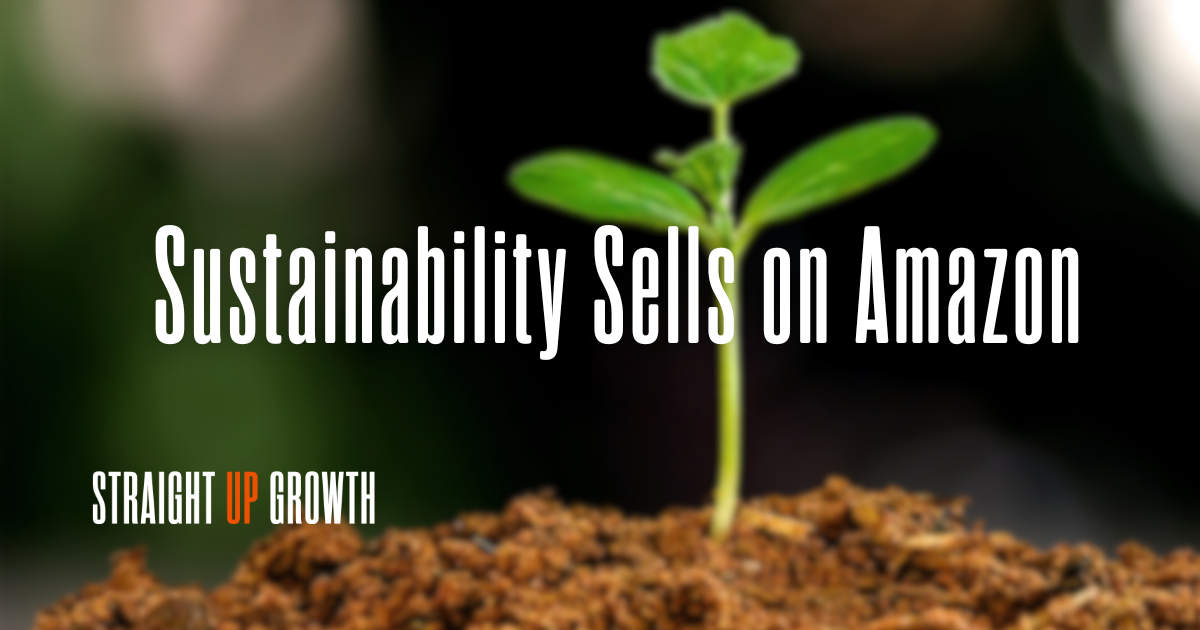Sustainability Sells on Amazon

There is a growing trend towards eco-friendly shopping, and consumers are increasingly seeking more sustainable products. Amazon is a key leader in the market, pushing for innovative sustainability efforts, such as committing to net-zero carbon emissions and investing in renewable energy projects. Consumers are actively seeking out products and brands that demonstrate environmental responsibility, and Amazon's platforms provide a powerful avenue for them to do so.
Let’s explore Amazon’s key sustainability programs and provide insights into how brands can align with these initiatives to benefit both their business and the environment.
II. Amazon’s Core Sustainability Initiatives
A. The Climate Pledge
The Climate Pledge, led by Amazon, represents a commitment to achieving net-zero carbon emissions by the year 2040. This initiative is significant because it serves as a catalyst, inspiring other global brands to prioritize and commit to environmental responsibility, thereby amplifying the impact of sustainable practices on a worldwide scale. The Pledge aims to bring together a community of companies dedicated to moving faster and inspiring greater climate action. By committing to an earlier net-zero target, signatories collectively push the boundaries of corporate climate ambition.
B. Climate Pledge Friendly Program
The Climate Pledge Friendly Program is a certification and labeling system designed to help customers identify and purchase eco-friendly products on Amazon. This program incorporates various recognized certifications, including Fairtrade, ENERGY STAR, and Carbon Trust. These certifications highlight products that meet specific sustainability standards. Additionally, it features Amazon's own "Compact by Design" metric, which identifies products with a more efficient design that reduces packaging and shipping emissions.
Ultimately, the Climate Pledge Friendly Program empowers consumers to make more sustainable purchasing decisions, contributing to a greener future. For brands, achieving Climate Pledge Friendly certification can enhance their visibility on the Amazon platform and appeal to a growing segment of environmentally conscious consumers.
C. Frustration-Free Packaging (FFP)
Frustration-Free Packaging (FFP) is an initiative designed to reduce packaging waste and enhance the unboxing experience for customers. The program operates through a tiered system, including Frustration-Free Packaging (FFP), Ships in Own Container (SIOC), and Prep-Free Packaging (PFP). The FFP program offers several advantages, such as:
- Cost Savings: Businesses can save money on packaging materials and shipping.
- Reduced Damage Rates: Products are less likely to be damaged during transit.
- Improved Customer Experience: Customers benefit from packaging that's easier to open and more environmentally friendly.
D. Amazon Aware
Amazon Aware is Amazon’s own line of sustainable products, designed to meet specific environmental and social standards. For third-party sellers, this initiative sets a benchmark for sustainability, providing both inspiration and competition. It encourages sellers to adopt higher standards in their product offerings and packaging while also facing direct competition from Amazon's sustainably focused product line.
Amazon Aware products are consciously designed with a strong focus on sustainability. Many items carry Carbon Neutral Certification, reflecting a commitment to offsetting their environmental footprint. A core principle of the brand is also to reduce packaging through innovative and efficient solutions.
Products in specific categories can also prioritize the use of sustainable resources, including:
- Apparel: Frequently crafted from organic cotton or recycled materials.
- Home Goods: Featuring materials like organic cotton for sheets and towels, and recycled paper for toilet paper. The range also extends to items like planters.
- Beauty & Personal Care: Formulations often incorporate bio-based ingredients such as vitamin C, avocado oil, and shea butter.
E. Sustainability in Operations
Amazon is committed to sustainability in its operations, aiming to achieve 100% renewable energy use by 2025. This commitment extends to the electrification of its delivery fleets and other significant upgrades in logistics. These changes are intended to reduce the company's carbon footprint and promote more environmentally friendly practices throughout its operational infrastructure.
III. How Brands Can Leverage These Programs
A. Become Climate Pledge Friendly
To become Climate Pledge Friendly, products must meet specific criteria, including obtaining third-party certification or qualifying for Amazon’s Compact by Design program. The benefits of achieving this status include increased visibility on the platform, enhanced shopper trust, and improved brand positioning as an environmentally conscious option.
B. Upgrade Packaging for Sustainability
Upgrading packaging for sustainability involves participating in programs such as Frustration-Free Packaging (FFP) or Ships in Own Container (SIOC). By participating in these initiatives, sellers can leverage incentives and improve product margins. Additionally, more innovative packaging solutions can reduce return rates, contributing to both environmental and economic benefits.
The benefits of upgrading to sustainable packaging include:
- Financial Advantages: Access potential discounts and avoid chargebacks from Amazon.
- Operational Efficiency: Products requiring less prep lead to smoother fulfillment.
- Customer & Brand Impact: Easier-to-open, less wasteful packaging boosts customer satisfaction.
- Environmental Contribution: More efficient packaging can result in reduced shipping volume and fewer overall deliveries.
C. Tell a Sustainability Story
To effectively communicate sustainability efforts, it's crucial to tell a compelling sustainability story. This involves using A+ content to highlight environmental values and mentioning relevant certifications and eco-friendly packaging on product detail pages. By doing so, brands can build trust with consumers and differentiate themselves in the marketplace, appealing to environmentally conscious shoppers.
Transform your A+ content into a powerful sustainability narrative. Use visuals to highlight products made from recycled materials, such as plastics, organic cotton, or bamboo. Showcase your eco-friendly manufacturing processes, such as water conservation or the use of renewable energy, through engaging images. Clearly explain how your packaging reduces waste or simplifies recycling for customers, reinforcing your commitment to the environment.
D. Advertising and SEO Opportunities
Advertising and SEO strategies can be enhanced by incorporating sustainability keywords, such as "eco-friendly," "biodegradable," and "organic," to attract environmentally conscious buyers. Tailoring Sponsored Ads to target green-minded consumers and leveraging marketplace segmentation can further amplify the reach and effectiveness of sustainable product listings.
E. Monitor and Adapt
To stay aligned with the latest sustainability practices, it is crucial to monitor and adapt by following Amazon's sustainability reports and updates. This includes regularly reviewing Amazon's sustainability reports and updates, which provide insights into their progress and new environmental goals. Additionally, actively engaging in relevant Amazon seller forums or participating in Climate Pledge partner discussions can provide invaluable insights, facilitate the exchange of best practices, and uncover collaborative opportunities to enhance sustainable operations further.
IV. Final Thoughts
In conclusion, it's strategically and ethically crucial for brand owners to align with Amazon’s green initiatives. Embracing sustainability should be viewed not only as a growth driver but also as a responsibility, contributing to a more environmentally conscious marketplace and a better future. By participating in programs like Frustration-Free Packaging, Climate Pledge Friendly, and the broader Climate Pledge, brands can significantly reduce their environmental footprint, appeal to a growing base of eco-conscious consumers, and drive innovation in sustainable practices. This alignment fosters a positive brand image, enhances customer loyalty, and positions companies as leaders in the global effort toward a more sustainable economy.
Contact Straight Up Growth for a complimentary audit, and we’ll demonstrate how to optimize your brand's operations, meet Amazon's sustainability standards, and achieve both environmental impact and revenue growth.
VI. Q&A: Top Questions from Amazon Sellers
1. How do I know if my product qualifies for the Climate Pledge Friendly badge?
Check the criteria on Amazon's Climate Pledge Friendly page to see if your product meets the requirements through certifications or sustainable practices. If your product qualifies, you can apply to get the badge.
2. Is it worth investing in Frustration-Free Packaging?
Yes, investing in Frustration-Free Packaging can reduce costs, improve customer satisfaction, and lower environmental impact by minimizing waste and damage. Beyond these direct benefits, it also enhances brand image and streamlines logistics, making it a strategic move for businesses.
3. How do I track the performance impact of these initiatives?
Monitor sales, customer feedback, and return rates before and after implementing sustainability initiatives to measure their impact on your business performance. Also consider tracking material usage reduction, packaging waste diverted from landfills, and customer sentiment specifically related to your sustainability efforts through surveys and social media monitoring.
4. Can smaller brands participate in these initiatives?
Yes, smaller brands can participate in these initiatives by meeting the certification standards and optimizing their packaging and product listings to highlight sustainable attributes. Many of the certifications are accessible to businesses of all sizes, and Amazon provides resources and guidelines to help even smaller brands align with their green goals.




